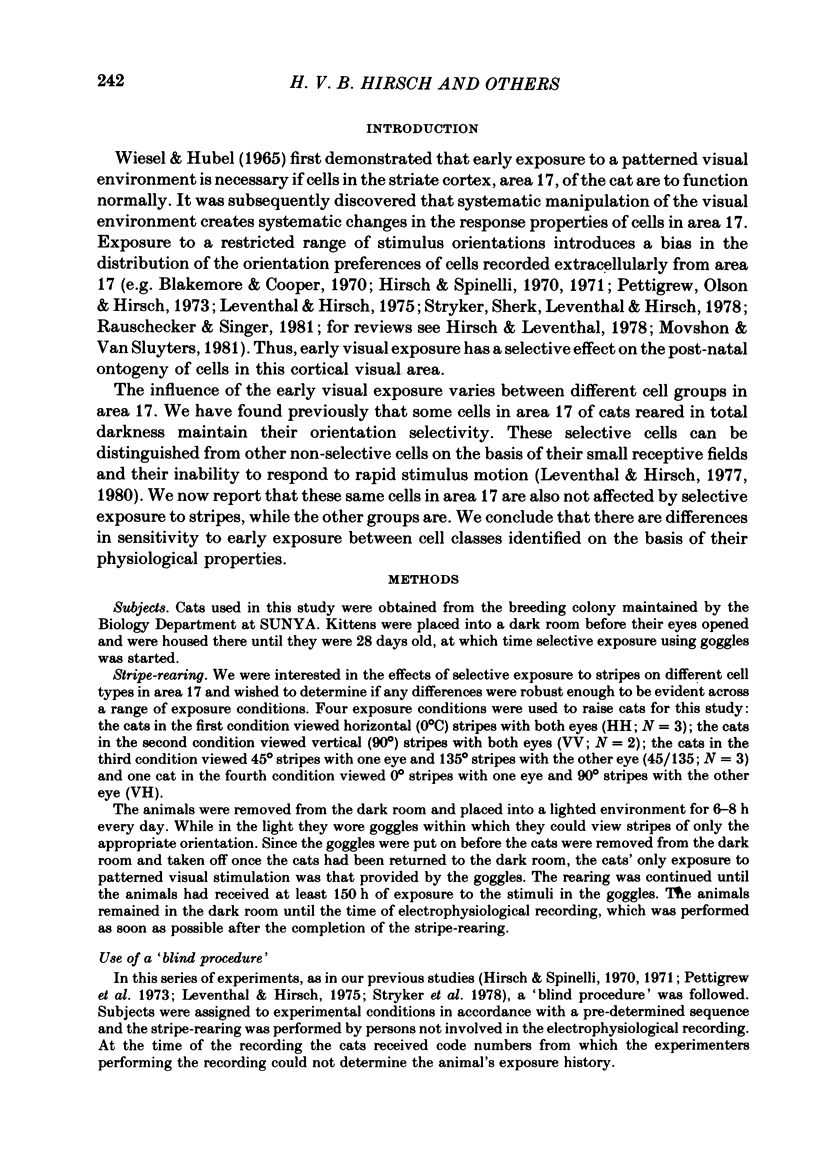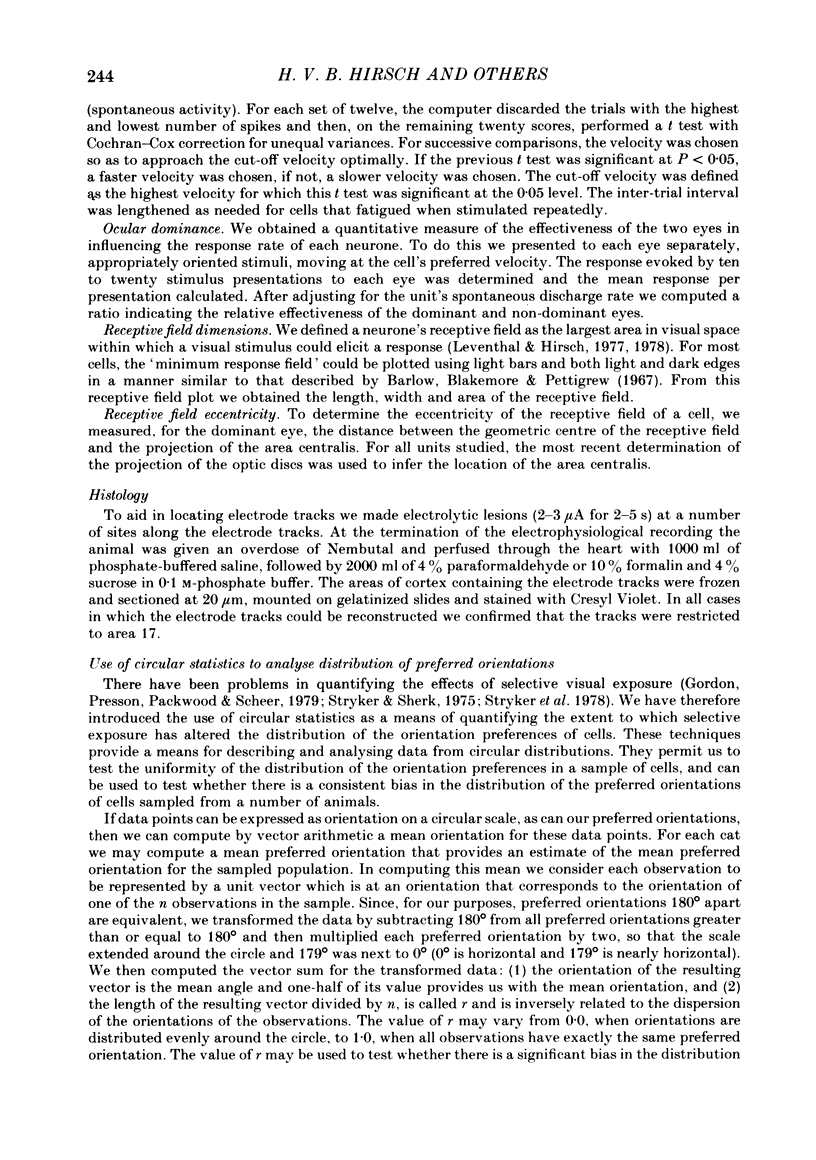Abstract
We raised cats using goggles to control early visual exposure (stripe-rearing). Four conditions were used: (a), both eyes exposed to 0 degrees lines, (b), both eyes exposed to 90 degree lines, (c), one eye exposed to 45 degree lines, the other to 135 degree lines, (d), one eye exposed to 0 degree lines, the other to 90 degree lines. At the completion of the rearing, we recorded extracellularly from single cells in striate cortex (area 17) of these animals; circular statistics were used to analyse the distribution of the orientation preferences of neurones recorded. Exposure to either one or two stimulus orientations produced a significant bias in the distribution of the orientation preferences of cells recorded. We found no more non-selective cells in cats exposed to one orientation (15%) than in cats exposed to two orientations (14%). We found about the same mean proportion of binocular cells in cats exposed to one orientation (27%) as in cats exposed to two orientations (24%). Cells were comparable in orientation selectivity in cats exposed to one orientation (mean half-width at half-height = 37 degrees) and in cats exposed to two orientations (mean half-width at half-height = 34 degrees). The effects of the rearing depended upon the receptive field properties of the cells. For cells with narrow receptive fields and low cut-off velocities, the rearing produced no bias in the distribution of the orientation preferences; for all other groups of cells the rearing produced a bias toward the exposed orientation. In addition, the cells with narrow receptive fields and low cut-off velocities were more finely tuned for orientation than the remaining cells. We conclude that there are cell types in the striate cortex of the cat which differ in their susceptibility to the effects of stripe-rearing; these cell types can be discriminated on the basis of their physiological characteristics. We can compare these cell types with morphologically identified cell types that also differ in their susceptibility to the effects of stripe-rearing.
Full text
PDF














Selected References
These references are in PubMed. This may not be the complete list of references from this article.
- BISHOP P. O., KOZAK W., VAKKUR G. J. Some quantitative aspects of the cat's eye: axis and plane of reference, visual field co-ordinates and optics. J Physiol. 1962 Oct;163:466–502. doi: 10.1113/jphysiol.1962.sp006990. [DOI] [PMC free article] [PubMed] [Google Scholar]
- Barlow H. B., Blakemore C., Pettigrew J. D. The neural mechanism of binocular depth discrimination. J Physiol. 1967 Nov;193(2):327–342. doi: 10.1113/jphysiol.1967.sp008360. [DOI] [PMC free article] [PubMed] [Google Scholar]
- Blakemore C., Cooper G. F. Development of the brain depends on the visual environment. Nature. 1970 Oct 31;228(5270):477–478. doi: 10.1038/228477a0. [DOI] [PubMed] [Google Scholar]
- Dreher B., Leventhal A. G., Hale P. T. Geniculate input to cat visual cortex: a comparison of area 19 with areas 17 and 18. J Neurophysiol. 1980 Oct;44(4):804–826. doi: 10.1152/jn.1980.44.4.804. [DOI] [PubMed] [Google Scholar]
- Fernald R., Chase R. An improved method for plotting retinal landmarks and focusing the eyes. Vision Res. 1971 Jan;11(1):95–96. doi: 10.1016/0042-6989(71)90207-0. [DOI] [PubMed] [Google Scholar]
- Gordon B., Presson J., Packwood J., Scheer R. Alteration of cortical orientation selectivity: importance of asymmetric input. Science. 1979 Jun 8;204(4397):1109–1111. doi: 10.1126/science.451557. [DOI] [PubMed] [Google Scholar]
- Hirsch H. V., Spinelli D. N. Modification of the distribution of receptive field orientation in cats by selective visual exposure during development. Exp Brain Res. 1971 Jun 29;12(5):509–527. doi: 10.1007/BF00234246. [DOI] [PubMed] [Google Scholar]
- Hirsch H. V., Spinelli D. N. Visual experience modifies distribution of horizontally and vertically oriented receptive fields in cats. Science. 1970 May 15;168(3933):869–871. doi: 10.1126/science.168.3933.869. [DOI] [PubMed] [Google Scholar]
- Leventhal A. G., Hirsch H. V. Cortical effect of early selective exposure to diagonal lines. Science. 1975 Nov 28;190(4217):902–904. doi: 10.1126/science.1188371. [DOI] [PubMed] [Google Scholar]
- Leventhal A. G., Hirsch H. V. Effects of early experience upon orientation sensitivity and binocularity of neurons in visual cortex of cats. Proc Natl Acad Sci U S A. 1977 Mar;74(3):1272–1276. doi: 10.1073/pnas.74.3.1272. [DOI] [PMC free article] [PubMed] [Google Scholar]
- Leventhal A. G., Hirsch H. V. Receptive-field properties of different classes of neurons in visual cortex of normal and dark-reared cats. J Neurophysiol. 1980 Apr;43(4):1111–1132. doi: 10.1152/jn.1980.43.4.1111. [DOI] [PubMed] [Google Scholar]
- Leventhal A. G., Hirsch H. V. Receptive-field properties of neurons in different laminae of visual cortex of the cat. J Neurophysiol. 1978 Jul;41(4):948–962. doi: 10.1152/jn.1978.41.4.948. [DOI] [PubMed] [Google Scholar]
- Levick W. R. Another tungsten microelectrode. Med Biol Eng. 1972 Jul;10(4):510–515. doi: 10.1007/BF02474199. [DOI] [PubMed] [Google Scholar]
- Movshon J. A., Van Sluyters R. C. Visual neural development. Annu Rev Psychol. 1981;32:477–522. doi: 10.1146/annurev.ps.32.020181.002401. [DOI] [PubMed] [Google Scholar]
- Mustari M. J., Bullier J., Henry G. H. Comparison of response of properties of three types of monosynaptic S-cell in cat striate cortex. J Neurophysiol. 1982 Mar;47(3):439–454. doi: 10.1152/jn.1982.47.3.439. [DOI] [PubMed] [Google Scholar]
- Pettigrew J. D., Olson C., Hirsch H. V. Cortical effect of selective visual experience: degeneration or reorganization? Brain Res. 1973 Mar 15;51:345–351. doi: 10.1016/0006-8993(73)90387-9. [DOI] [PubMed] [Google Scholar]
- Rauschecker J. P., Singer W. The effects of early visual experience on the cat's visual cortex and their possible explanation by Hebb synapses. J Physiol. 1981 Jan;310:215–239. doi: 10.1113/jphysiol.1981.sp013545. [DOI] [PMC free article] [PubMed] [Google Scholar]
- Schiller P. H., Finlay B. L., Volman S. F. Quantitative studies of single-cell properties in monkey striate cortex. I. Spatiotemporal organization of receptive fields. J Neurophysiol. 1976 Nov;39(6):1288–1319. doi: 10.1152/jn.1976.39.6.1288. [DOI] [PubMed] [Google Scholar]
- Stryker M. P., Sherk H., Leventhal A. G., Hirsch H. V. Physiological consequences for the cat's visual cortex of effectively restricting early visual experience with oriented contours. J Neurophysiol. 1978 Jul;41(4):896–909. doi: 10.1152/jn.1978.41.4.896. [DOI] [PubMed] [Google Scholar]
- Stryker M. P., Sherk H. Modification of cortical orientation selectivity in the cat by restricted visual experience: a reexamination. Science. 1975 Nov 28;190(4217):904–906. doi: 10.1126/science.1188372. [DOI] [PubMed] [Google Scholar]
- Tieman S. B., Hirsch H. V. Exposure to lines of only one orientation modifies dendritic morphology of cells in the visual cortex of the cat. J Comp Neurol. 1982 Nov 10;211(4):353–362. doi: 10.1002/cne.902110403. [DOI] [PubMed] [Google Scholar]
- Wiesel T. N., Hubel D. H. Comparison of the effects of unilateral and bilateral eye closure on cortical unit responses in kittens. J Neurophysiol. 1965 Nov;28(6):1029–1040. doi: 10.1152/jn.1965.28.6.1029. [DOI] [PubMed] [Google Scholar]


